
- Address : P.O. Box 11, Gannoruwa rd, Peradeniya, Sri Lanka
- E- Mail : director.hordi@doa.gov.lk
- Telephone :(+94) 081-2388011-12-13
- Fax :(+94) 081-2388234

Tomato
Solanum lycopersicon
Popular vegetable crop belonging to family Solanaceae. Can be grown in almost all agroclimatic zones in Sri Lanka except up country wet zone. It is an important cash crop and also has a good potential for export. Tomato fruit rich in vitamin A, C and minerals.
Released Varieties
- HORDI Tomato hybrid 03
- Thilina
- KWR
- T245
- Ravi
- Lanka Sour (Goraka Takkali)
- Maheshi
- Tharindu
- Rajitha
- Rashmi
- Bhathiya
- KC 1
- Lanka Cherry
Climatic requirements/ Areas suitable for cultivation
Optimum climatic conditions are
- 21oC-24oC temperature
- Soil pH should be in between 5.5-7.5
- Elevation 1000-2000 m
Soil
Although Tomato is moderately tolerant to a wide range of pH, it grows well in soils with a pH of 5.5-7.5. Addition of organic matter is favorable for a better growth.
Seed requirement
200-250 g/ha
Nursery Management
Suitable period for nursery establishment is mid of March or end of August. 1 m x 3 m size raised bed (about 15-20 cm raised) is recommended. Remove clods of earth and stubble. Mix well decomposed farmyard manure and top soil 1:1 ratio and lay on the bed to 5cm thickness. Add paddy husk and straw layers on the surface of the bed and fire from the opposite to the wind direction and burn the nursery bed. Apply 2g of a fungicide (Captan or Thiram) to 125g of seeds as a seed treatment before place in the nursery. Mark lines on the nursery bed each 12 -15 cm apart and 0.5 cm deep perpendicular to the long side of the nursery bed. Sow the seed as a thin layer on the lines. Cover the seeds with fine soil layer. Mulch the nursery bed using clean paddy straw and water the nursery bed daily and sufficiently.
Land preparation
Harrow the field deeper and break in to a fine soil. Mark planting holes according to given spacing and fill the holes with decomposed manure or organic matter (6-12 mt/ha). Drains should be prepared to avoid water retention. Apply basal inorganic fertilizer 2-3 days before transplanting
Planting
Transplant the seedling to the field 14-18 days after sowing. A week before transplanting seedlings should be hardened by reducing the application of water but 12-14 hours before transplanting the seedbed they should be thoroughly watered again to avoid excessive damage to the roots well grown. Healthy Seedlings with 3-5 true leaves are most suitable for transplanting. Transplanting should be done in an afternoon minimize the transplanting shock. After transplanting, the new transplants should be covered with Glinisidea trees or any similar plant twigs provide shadow
Spacing
80 cm x 50 cm
Fertilizer
Mix 10 t/ha of well decomposed organic matter with the soil of selected field. Additionally apply chemical fertilizer as below recommendation. Apply basal fertilizers 2-3 days before planting
Chemical fertilizer recommendation for all district except Badulla District.
Time of application | Urea kg/ha | TSP kg/ha | MOP kg/ha |
Basal fertilizer – 1-2 days before planting | 65 | 325 | 65 |
1st Top dressing (03 weeks after planting) | 65 | – | – |
2nd Top dressing ( 06 weeks after planting) | 65 | – | 65 |
Apply the above recommended triple super phosphate per hectare for Badulla District at the rate of 215 kg / ha.
Water supply
Don’t apply excess water specially in dry season. It causes fruit crack.
Weed Control
Always keep the cultivation free of weeds. It will reduce the risk of pest attack and disease infection. When plants are young specially 3-6 weeks after transplant, remove weeds by hand around the plants. And also weeding should be done before apply fertilizers.
Pest Management
Disease Management
- Fungal diseases
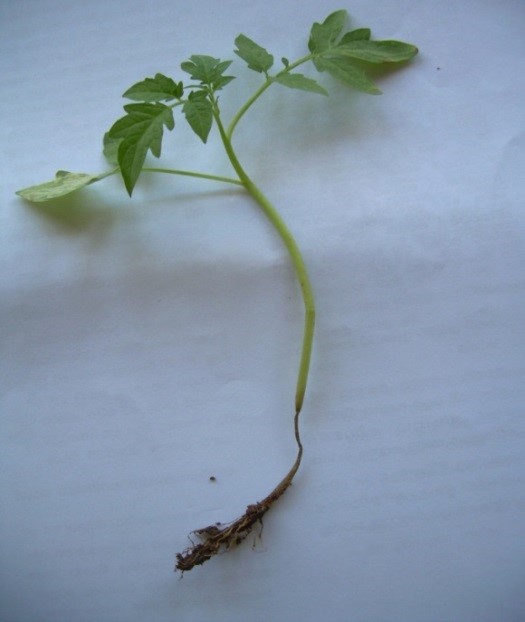 |
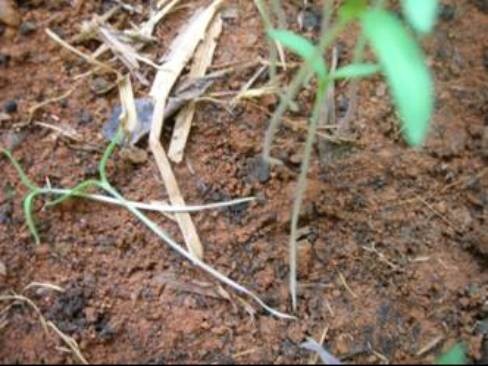 |
- Virgin lands for nursery beds preparation
- Heat sterilization
- Seed Treatments – Thiram 80wp 5g/1Kg or Homai 4g/1kg
- Soil treatments – Thiram 80wp 7g/5 l/m-2 or Homai 5g/5 l/m-2
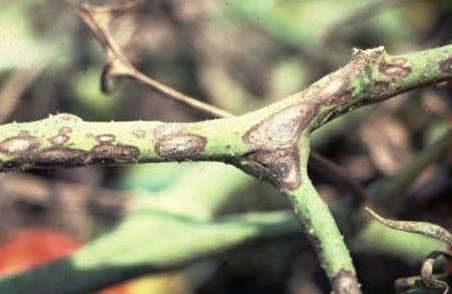 |
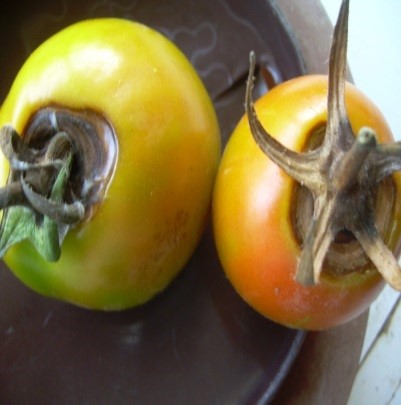 |
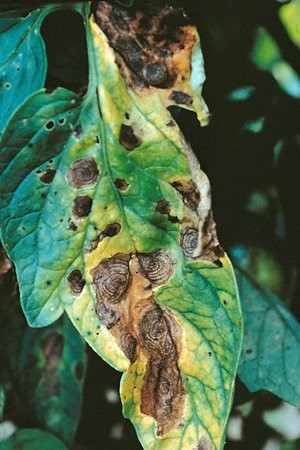 |
- Use recommended fungicides at initial stage of disease development (Refer: Pesticide recommendation DOA, 2019)
- First appear on the lower, older leaves as water-soaked grey-green spots.
- Later spots darken and a white fungal growth forms on underside
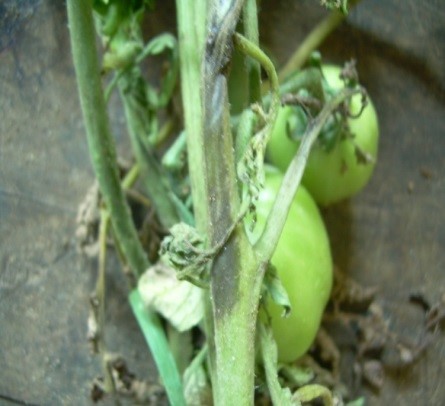 |
 |
 |
- Use recommended fungicides at initial stage of disease development (Refer: Pesticide recommendation DOA, 2019)
- Circular, dark brown necrotic lesions in a concentric pattern on leaves and surrounded by a yellow halo and spread to all the leaflets
- Leaves turn yellow and rapidly collapse and die
- Spots also occur on the stem and fruits
 |
- Light green to bright yellow lesions on the upper surface of the leaf
- Lower surface develop white powdery patches when the fungus sporulation
- Severe infection result in leaf defoliation
 |
- Use recommended fungicides at initial stage of disease development (Refer: Pesticide recommendation DOA, 2019)
- Apply sulfur 80% WG 50 g/10 l of water
- Chlorothalonil 500g/l SC- 30 ml/10 l of water
- Carbendazim 50% WP- 7 g/10 l of water
- Die-back from apical buds, Flower dropping
- Black , sunken leaf, stem and fruit lesions
- Fruit rot
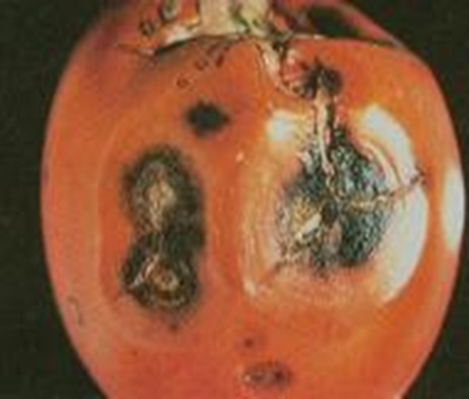 |
- Seed treatment with recommended fungicides before seed sowing
- Use recommended fungicides at initial stage of disease development (Refer: Pesticide recommendation DOA, 2019)
Causal organism: Septoria lycopersici
Symptoms: Water soaked areas on affected leaves become circular with brown to gray centers.
Control: Use recommended fungicide
Daconil 15- 30 ml/10L
Mancozeb 20 ml/10L
Topsin 6g/10L
Carbandazim 7g/10L
Causal organism: Fusarium spp., Rhizoctonia spp., Sclerotium spp.
Disease symptoms:
The pathogen attacks the collar portion of plant, The infection leads to the drying of lower leaves and eventually the whole plant dries giving a typical symptom of wilting which ultimately leads to its death.
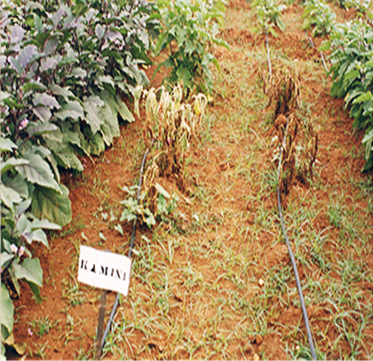 | 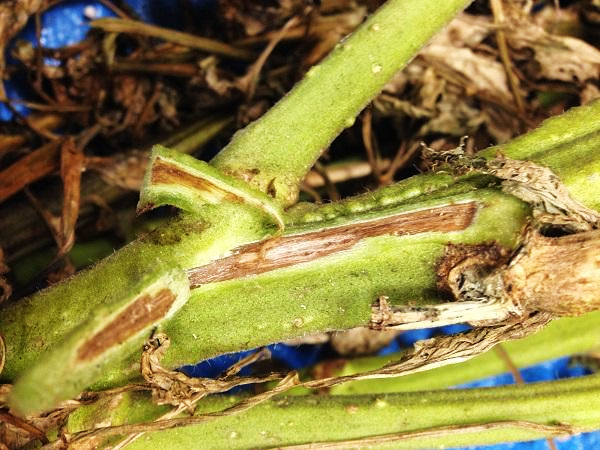 |
- Bacterial diseases
Causal organism: Ralstonia solanacearum
Disease symptoms
- Permanent wilting of the plant during optimum water level in the soil
- Viscous ooze exude at the cut end when immersed in water
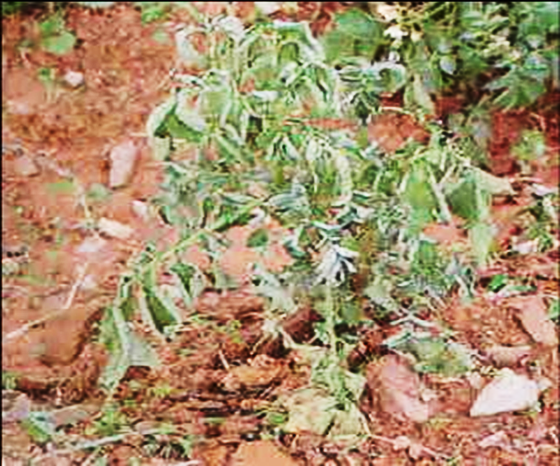 | 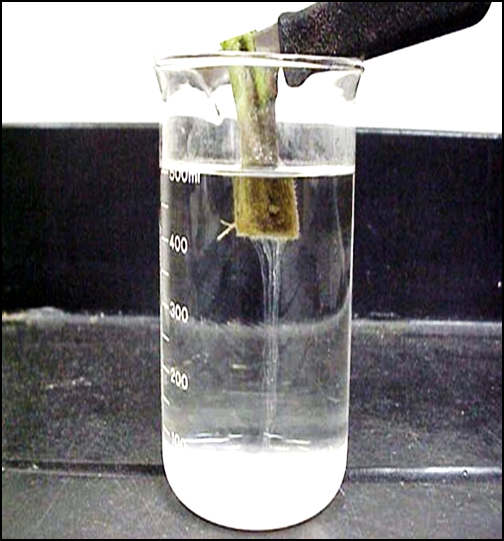 |
Management
- Use wilt resistant varieties
- Crop rotation with legumes, cereals etc.
- Maintain Field sanitization
Causal organism: Clavibacter michiganensis subsp. michiganensis (Cmm)
Disease symptoms:
- Tomato leaves edges turn brown, with a yellow border
- Wilt on lower leaves, often on one side only.
- Entire plant may collapse and die.
- Brown streaks can be seen in the vascular system when the stem is cut open.
- Stem splits forming long, brown cankers.
- Internal discoloration of stem from bacterial canker
- Small, creamy, white spots with tan or brown centers on fruit (bird eye spot).
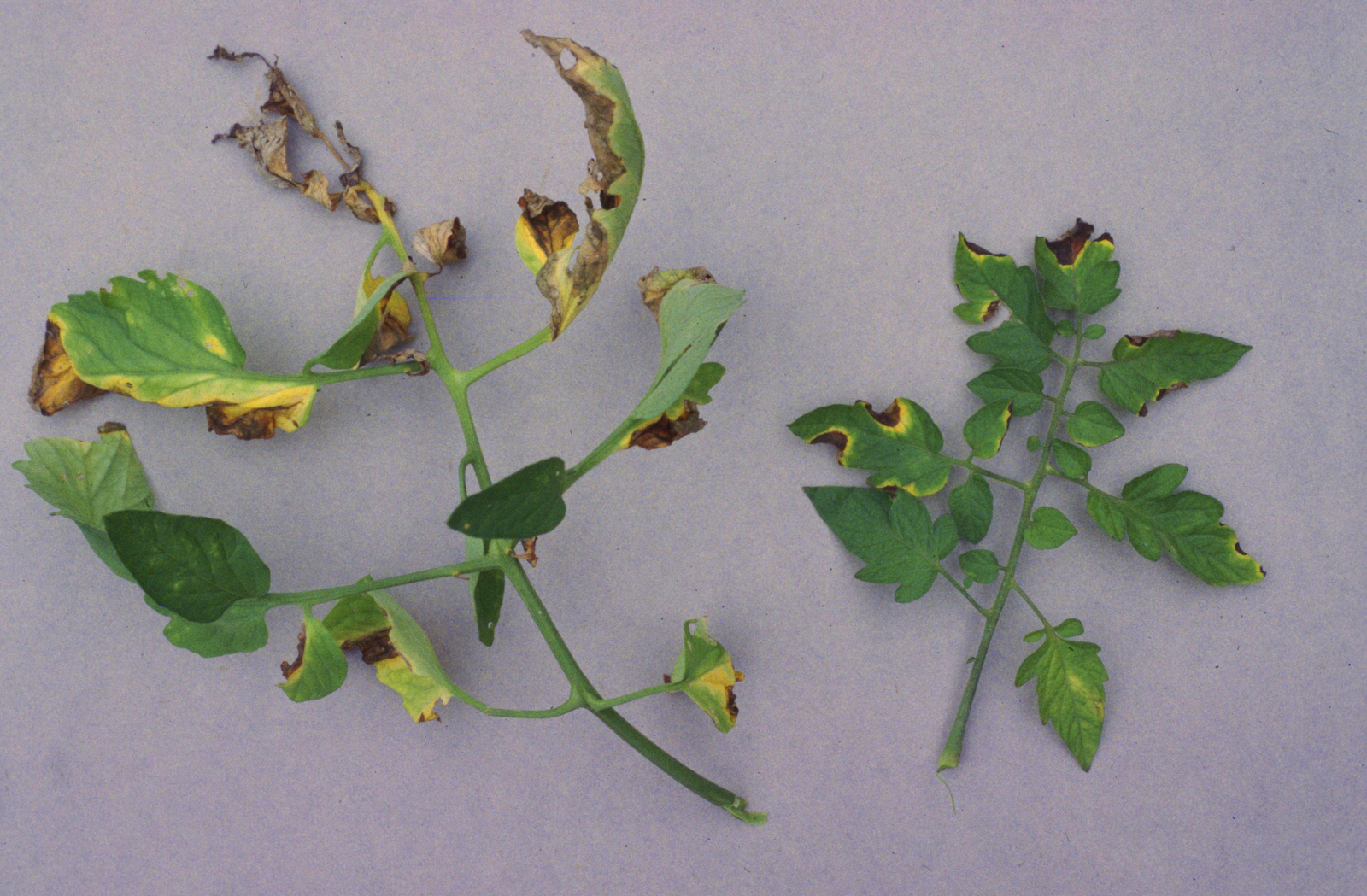 | 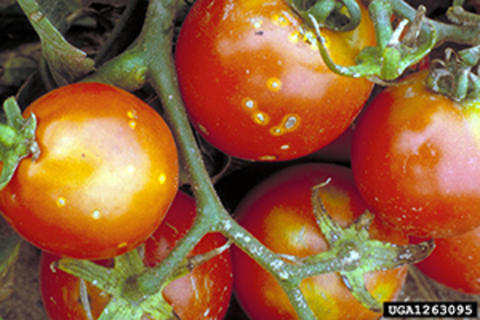 |
Management
- Use of healthy seeds
- Crop rotation
- Maintain sanitation in the field
- Viral diseases
TYLCV transmitted by whiteflies.
Symptoms
- Upward curling of leaves
- Yellow (chlorotic) leaf margins
- Smaller leaves than normal
- Plant stunting and flower drop
- If tomato plants are infected early in their growth, there may be no fruit formed
- Infected plants may appear randomly throughout the Field
Prevention & Treatment:
- Eliminating weeds
- Remove the old crop debris
 |
Virus disease Management
- Use disease free seeds
- Weed free field and field sanitation
- Reduce vector population (By insecticides)
Transmitted by : Leaf hoppers
- Inward rolling of leaflets along the midrib
- Petiole and midrib frequently curve downwards, giving the leaf a drooping but not wilting appearance
- Leaves are thick, crisp, brittle and dull green in color with purple veins
Prevention & Treatment:
- Eliminating weeds
- Remove the old crop debris
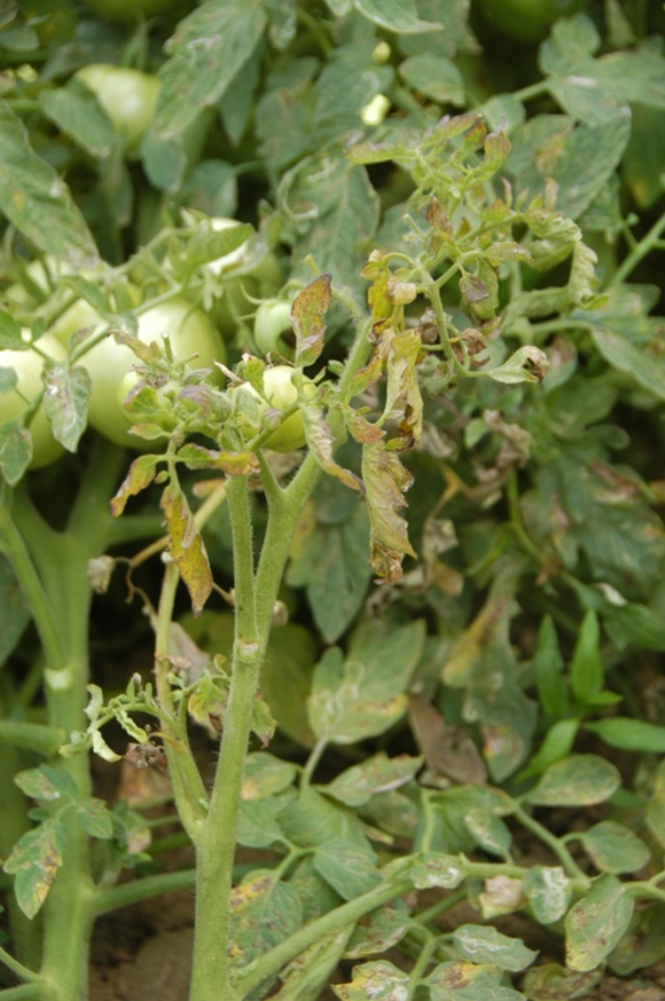 |
Virus disease Management
- Use disease free seeds
- Weed free field and field sanitation
- Reduce vector population (By insecticides)
TSWV is spread by a tiny insect called thrips
Symptoms
- Plants show bronzing, curling, necrotic streaks and spots on the leaves
- Dark-brown streaks also appear on leaf petioles, stems and growing tips
- Plants are small and stunted
- The ripe fruit shows paler red or yellow areas on the skin
- Plants are killed by severe necrosis
Prevention & Treatment:
- Eliminating weeds
- Remove the old crop debris
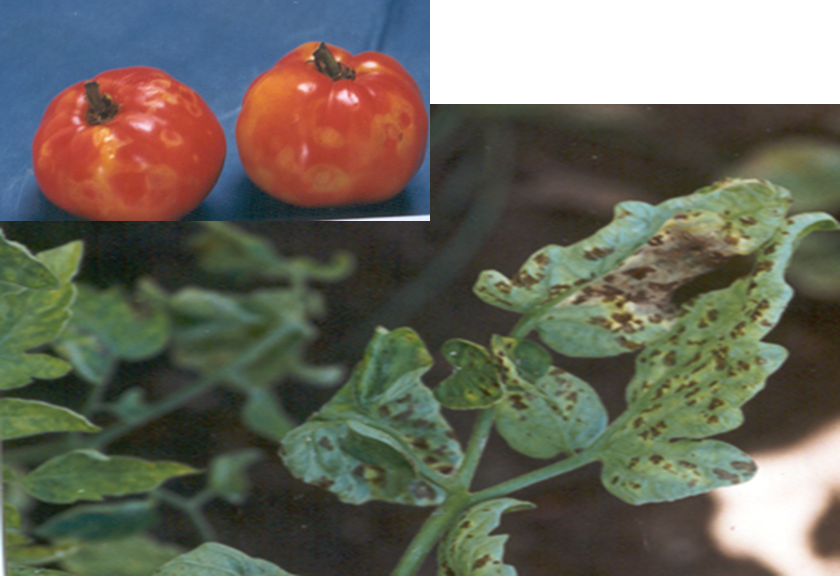 |
Virus disease management
- Use disease free seeds
- Weed free field and field sanitation
- Reduce vector population (By insecticides
CMV transmit by aphids
Symptoms:
- Early stages are yellow, bushy and considerably stunted. Later, filiformity or shoestring-like leaf blades
- Shoestring like leaf blades
- Leaf mottling
 |
Virus disease management
- Use disease free seeds
- Weed free field and field sanitation
- Reduce vector population (By insecticides)
Harvesting
Harvesting is done when the fruits reach green yellow. The fruits should be sorted according to the size and quality and should be stored in a well aerated place.
Yield
Varies with season, variety and climate. Normally yields about 20-30 tons per hectare.
